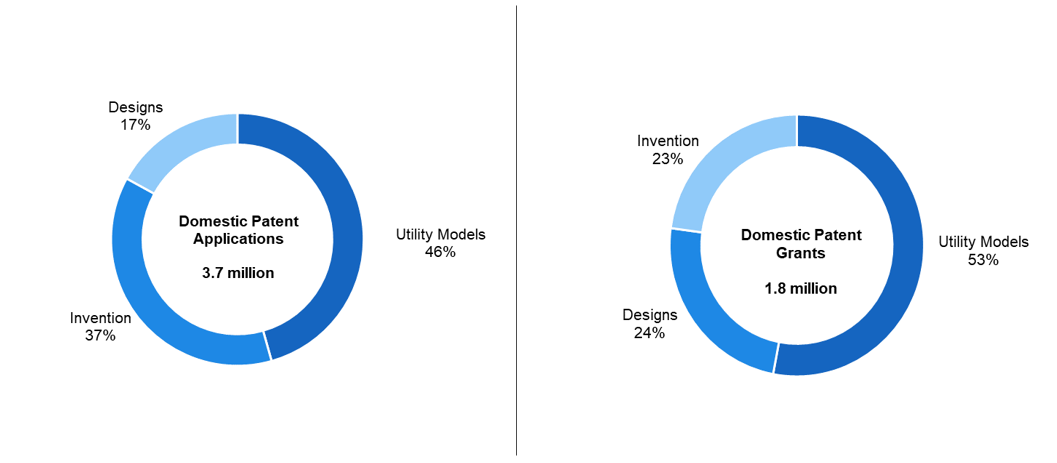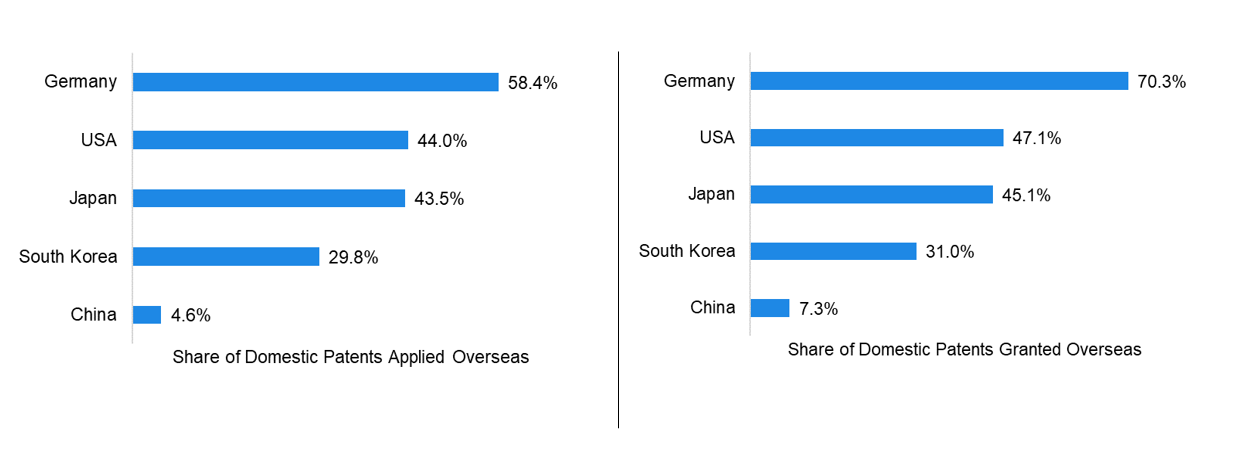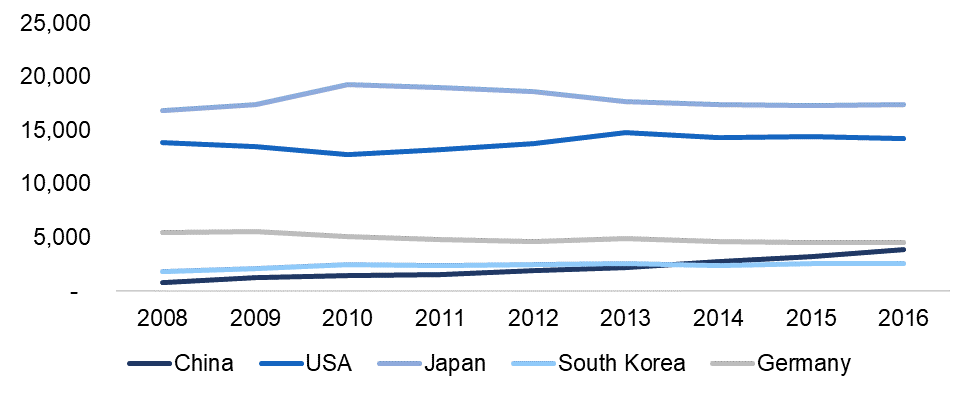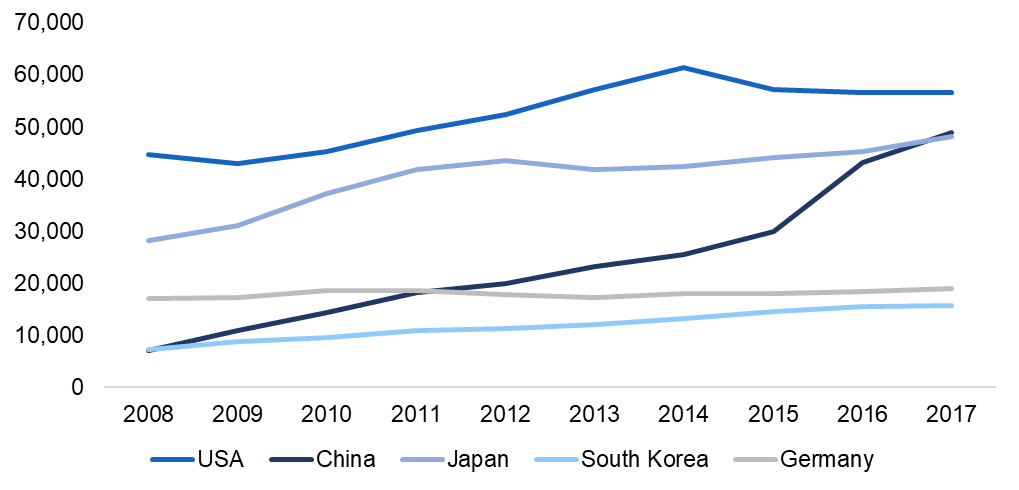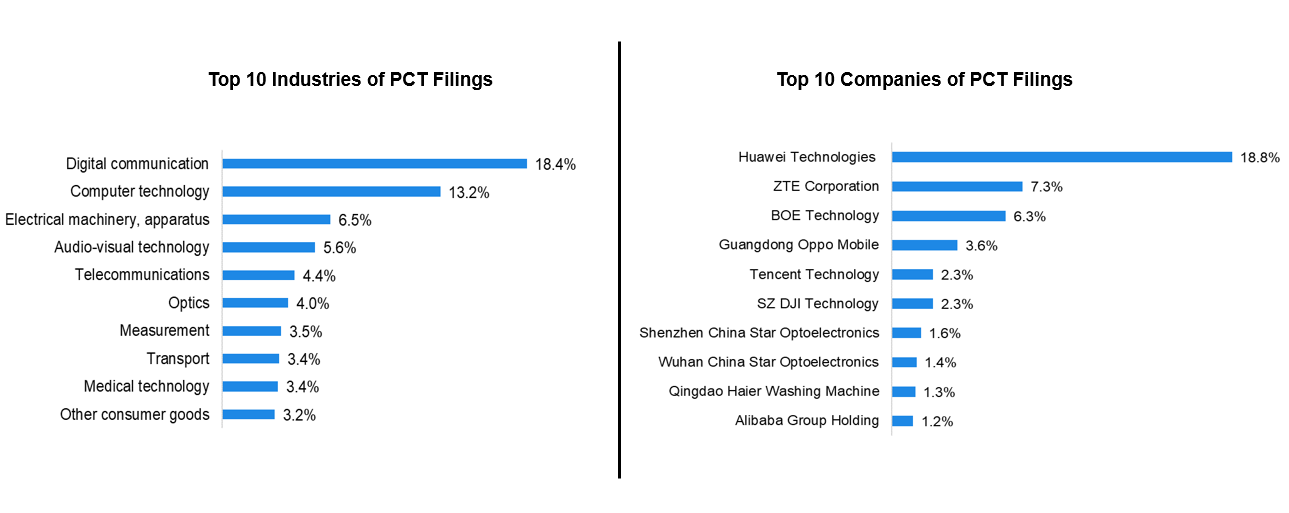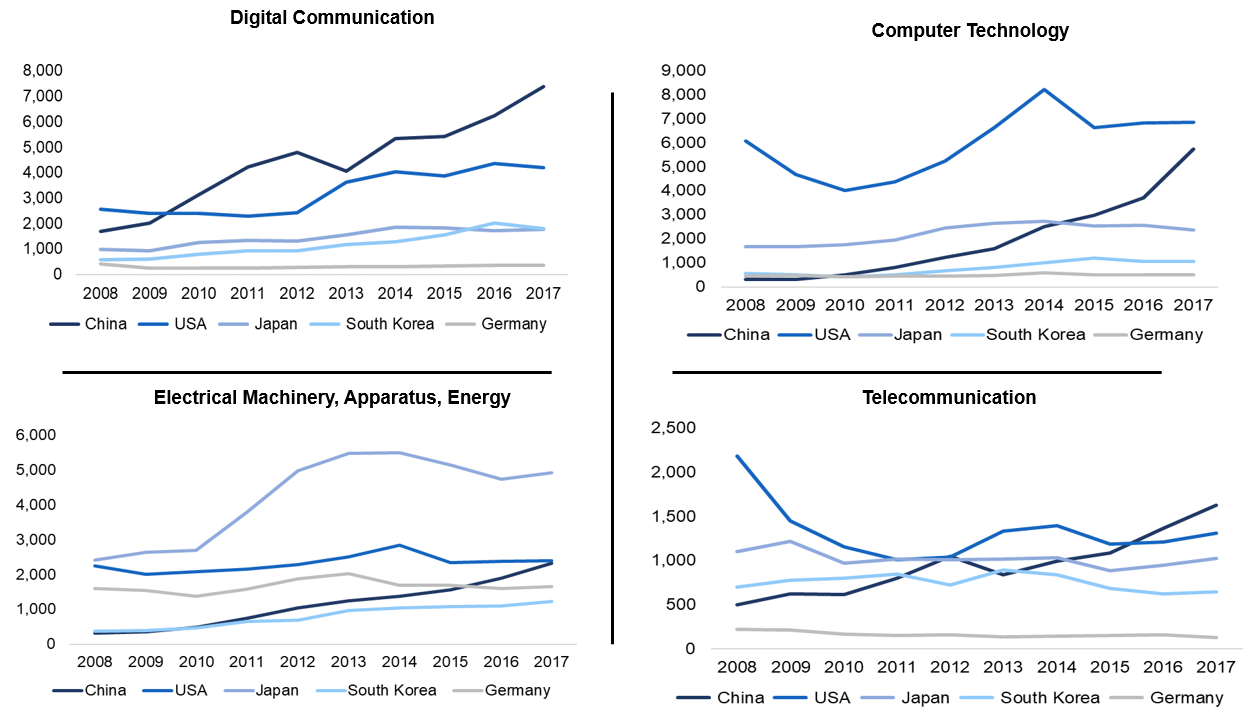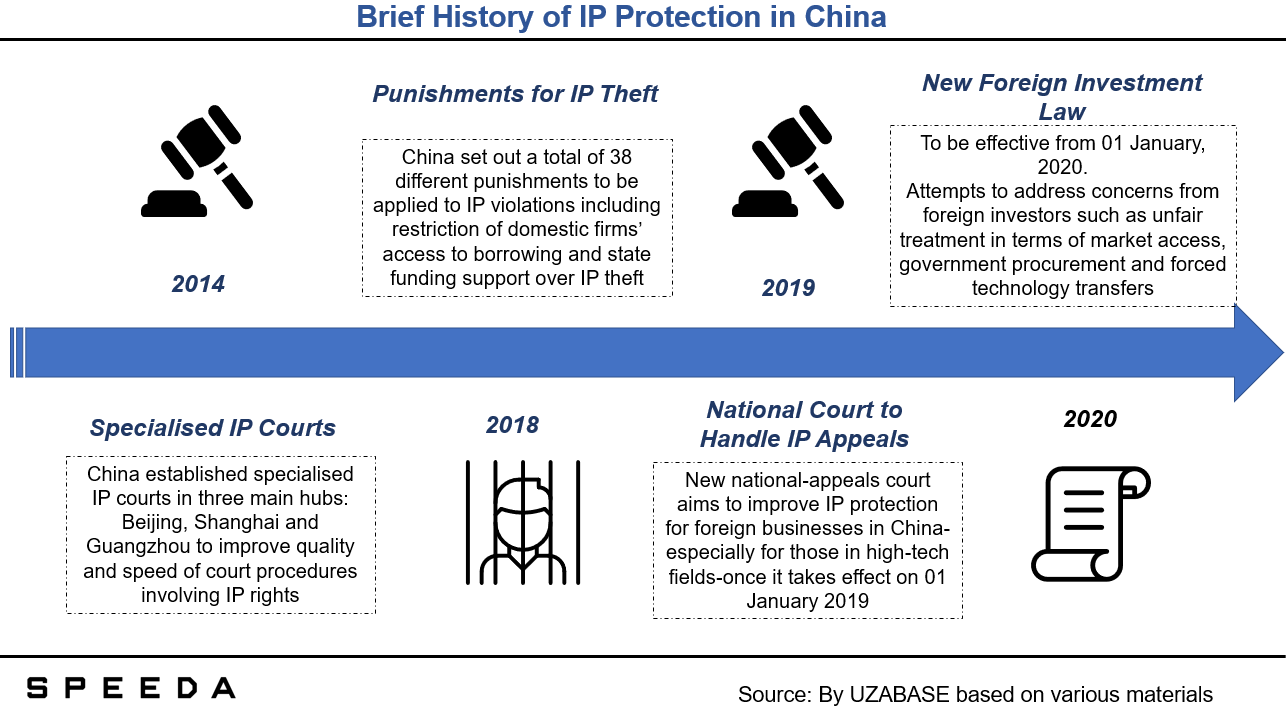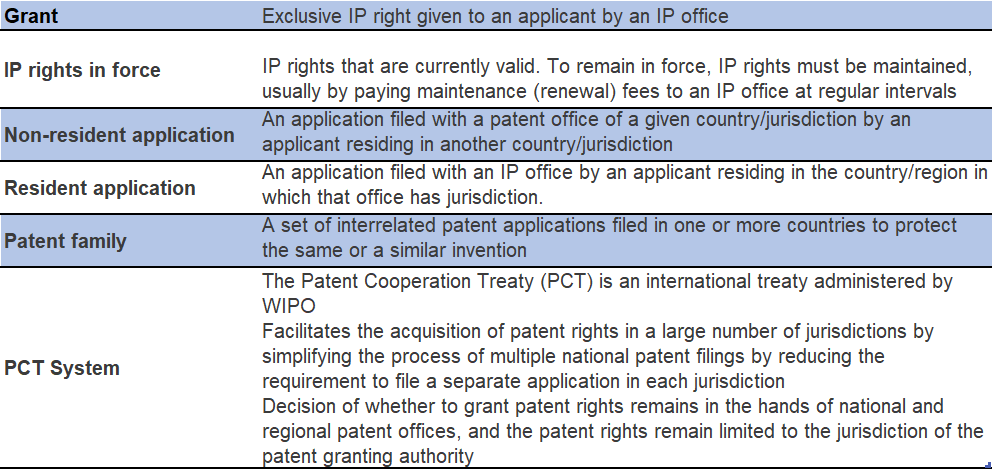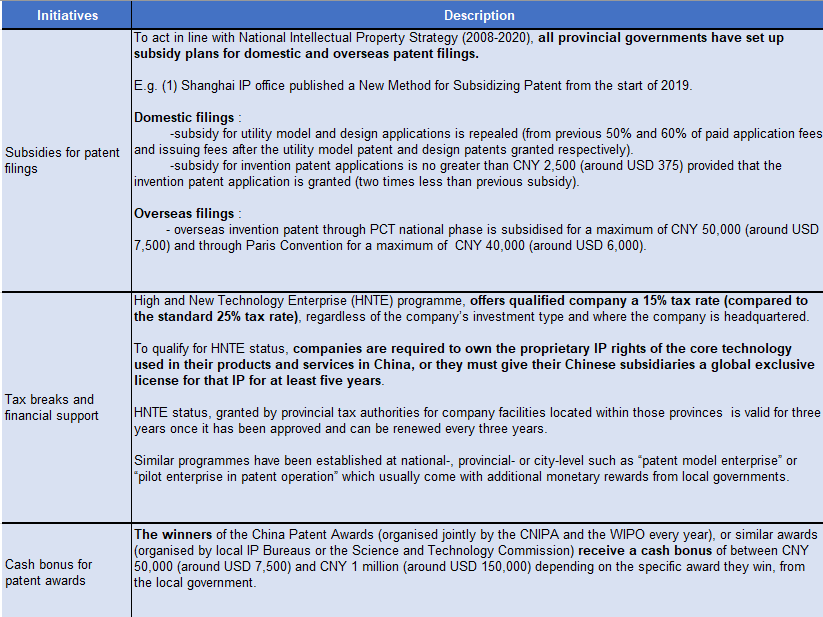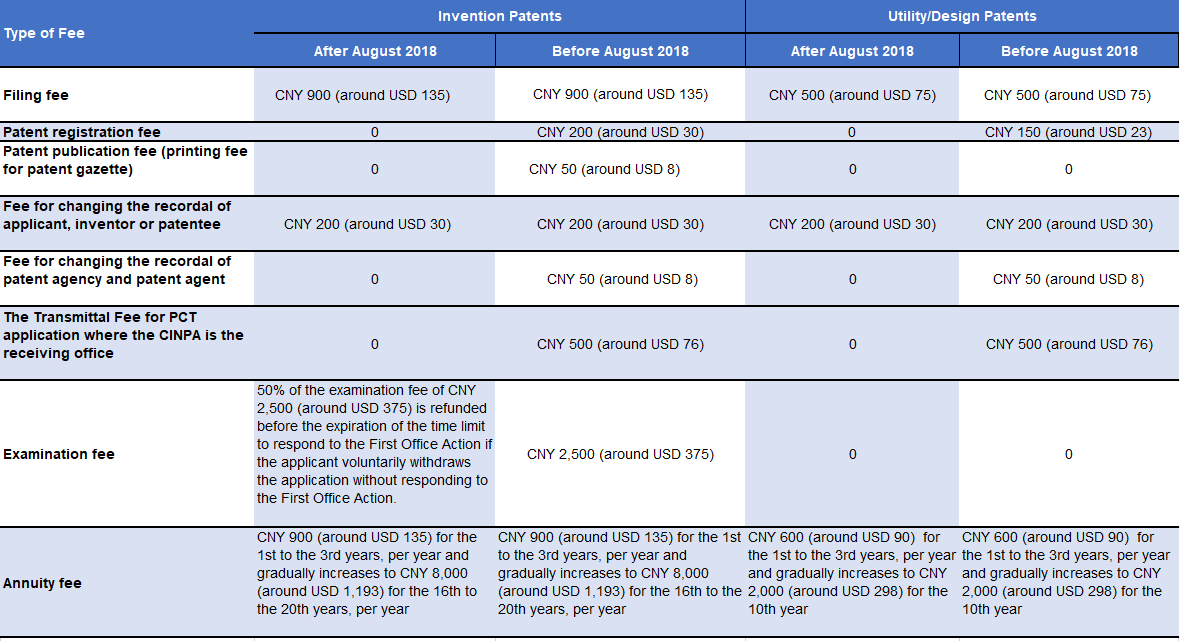Intellectual Property : Is China the Global Leader in Innovation?
|
Intellectual property (IP) refers to the product of the human intellect and is one way to measure innovation – a country’s ability to develop new products and production methods. China’s patent office, CNIPA, continued to receive the world’s most patent applications (~44% in 2017) and granted the most patents (~30% in 2017). |
|
A significant part of patent application growth is attributed to the Chinese government’s patent promoting policies such as direct subsidies on patent filing fees, rewards for granted patents, and corporate tax reductions for innovative companies. In addition, strong economic growth, and government policies such as “Science and Technology Development” and the more recent “Made in China 2025” with an underlying focus on local technology acquisition and development also contribute to the growth. |
|
Despite dominating patent filings globally, we note that China considerably lags global peers in terms of patent quality, given that most patents applied for and granted in China are low-quality utility models and designs with high attrition rates. Further, invention patents’ grant-to-application ratio remains well below other innovative nations whilst the country lags in terms of share of domestic patents filed or granted abroad. Although this low patent quality means that China is not yet the world leader in innovation, it is still notable that the country has made great strides in the past decade. This is reflected in significant growth in triadic patent and PCT applications globally, which can be considered high-quality patents. |
|
Considering China’s PCT patents by industry, digital communication accounted for the highest share in PCT publications in China in 2017 (~20%) followed by computer technology (~15%) and electrical machinery, apparatus, and energy (~6%). By company, Huawei Technologies and ZTE Corporation, leading telecommunications equipment manufacturers, led PCT applications with shares of ~19% and ~7%, respectively, in 2018. |
|
Further, IP protection remains a key concern among foreign businesses which, in fact, has partly led to the ongoing trade war between the USA and China. China has taken several measures, ranging from opening specialised IP courts and tribunals to the implementation of an array of punishments including restrictions of local companies’ access to borrowing and state-funding support over IP theft. More importantly, a new foreign investment law was passed in March 2019 which would come into effect from January 2020. Once implemented, this law is expected to create a level playing field for foreign businesses operating in China by easing pressure on technology transfers. |
|
China: World’s Largest Contributor to Patent Filing and Grants |
|
Intellectual property (IP) refers to the product of the human intellect such as inventions; literary and artistic works; and symbols, names and images that are protected by law allowing their owners to benefit from their own work or investment in a creation. IP is one way to measure innovation – a country’s ability to develop new products and methods of production. According to the World Intellectual Property Organization (WIPO), IP is categorised as Patents, Copyrights, Industrial Designs and Trademarks. |
|
|
|
In this report, we examine China’s global positioning as an IP creation hub and we use patent-related information as a key indicator of IP creation. China has a key difference in their IP laws, where China’s Patent Law covers (1) the protection of rights over technological inventions (new or improved technical solution for a product or a process; also known as “invention patents”) similar to the UK, as well as (2) utility models (new technical solution for the shape and/or structure of a product fit for practical use) and (3) designs (distinctly different from the existing designs or the combinations of the features of existing designs; also known as “design patents”). |
|
|
|
As per the WIPO, in 2017, China was (1) the largest source of patent filing activity in the world (~1.4 million; ~44% share), (2) the largest in terms of patent grants (~0.42 million; ~30% share), and (3) the second-largest in terms of patents in force (~2.1 million; ~15% share). Both patent filings and grants in China recorded impressive growth over 2008–17 (~19% and ~18% CAGR, respectively), while other patent offices witnessed only single-digit growth rates. Further, China has been #1 in terms of patent filings since 2011 and #1 in terms of patent grants since 2015. |
|
|
|
China Witnesses Impressive Growth in Patent Filings and Grants |
|
|
|
Source: Created by UZABASE based on WIPO “IP Facts and Figures” |
|
Note: China’s patent figures include only invention patents |
|
Government Policies Promoting IP Play a Big Part in China’s Impressive Patent Filings |
|
The impressive growth in patent filings in China discussed above is broadly driven by (1) government policy, and (2) underlying economics/business. |
|
01. Policy-driven factors |
|
The National Patent Development Strategy (2011-2020) of the National Intellectual Property Administration (CNIPA; Chinese Patent Office) called for government incentives to raise the number of domestically-filed patents and, more importantly, explicitly equated patent generation with innovation. This resulted in patents being awarded for small design tweaks and incremental changes as opposed to entirely new inventions. As a result, a large share of invention patent application growth in China originates from Chinese residents (26.1% CAGR over 2008–17) in contrast with non-residents (CAGR of 4.5%) with residents’ share of patent applications reaching 90% in 2017 from ~67% in 2008. |
|
Further, the Chinese government has implemented several other patent-promoting policies such as (1) direct subsidies on patent filing fees, (2) rewards for granted patents, and (3) certification of the prestigious High and New-Technology Enterprise (HNTE) status, granting a reduced corporate tax rate of 15% for innovative companies compared to the normal corporate tax rate of 25%. |
|
In addition, since 1 August 2018, China has waived off official patent fees to reduce the cost burden to applicants and patent owners thus encouraging patent filings, in contrast to the USA, which has substantially increased some of its patent fees since January 2018. For instance, the invention patent official examination fee in China stands at around USD 375, significantly less than that in the USA (at around USD 760) and Japan (JPY 118,000 or around USD 1,053). In our view, this more recent move suggests that the Chinese government is likely to continue supporting IP filing activity via policy-related incentives. |
|
The Bulk of Patent Application Growth in China Stems from Chinese Residents |
|
|
|
Source: Created by UZABASE based on WIPO “Statistical Country Profiles” |
|
Note: China’s patent applications figure includes only invention patents |
|
|
|
02. Underlying economic/business-related factors |
|
Although a considerable portion of patent-filing growth is driven by patent-promoting policies as discussed above, other factors such as strong economic growth and industrialisation have also partly contributed to the growth. Further, successive Chinese administrations have implemented policies ranging from plans for “Science and Technology Development” to the more recent “Made in China 2025”, with an underlying focus on local technology acquisition and development to enhance innovation. Further, China’s Gross Domestic Expenditure on R&D (GERD) at constant prices rose at a double-digit CAGR of ~12.9% over 2008–17 in contrast to just single-digit growth recorded by its competitors which, in our view, would have contributed significantly to IP creation in China. |
|
China’s R&D Witnessed Strong Growth Over Past 10 years |
|
|
|
Source: Created by UZABASE based on OECD “Main Science and Technology Indicators” |
|
Quantity vs Quality: Chinese Patent Quality Remains Low, Indicating Nation is Yet to Claim the Top Spot on Innovation |
|
Whilst China is global #1 in terms of patent filings and grants (ahead of other key contributors USA, Japan, South Korea and Germany), we believe that another important factor that should be taken into account is quality of patents as the number of patent applications is an imperfect measure of innovation. China is now among the top 20 most innovative economies globally as it moved to 17th place among 126 countries on the 2018 Global Innovation Index (annual ranking of countries by their capacity for, and success in, innovation) up from 22nd place in 2017 and 43rd place in 2010. However, it should also be noted that the USA (6th), South Korea (12th) and Japan (13th) remain ahead of China in terms of innovation. Thus, as discussed below, we analysed several quality-related factors and all these factors indicate that the quality of patents applied and granted in China is low compared to its peers. |
|
01. Majority of Patent Applied and Granted in China are Low-Quality Utility Models and Designs |
|
China identifies three types of patents: invention patents, utility models, and design patents. Invention patents, which indicate a breakthrough in design, process or concept and is thus an important indicator of innovation, accounted for only 37% of total patent applications and 23% of total patent grants in the country in 2017. Thus, the high number of patent applications and grants is on account of the other two categories, which are only examined for compliance with minimal administrative requirements. |
|
Utility Models Dominate Patent Applications and Grants in China, 2017 |
|
|
|
Source: Created by UZABASE based on WIPO and CNIPA |
|
02. China has Recorded High Attrition Rates of Patents |
|
As of 2017, more than 91% of design patents, 61% of utility model patents and 37% of invention patents granted in 2013 were discarded due to stoppage of maintenance fee payment as per Bloomberg. In comparison, only ~14% of US patents granted in 2013 were discarded by 2017. Patents with longer lifespans are more valuable, as holders only choose to pay recurring maintenance fees if the patent is still worth upholding. As a result, patents in force in China (2.1 million in 2017; 15.3% of global patents in force) were only ~70% of those in force in the USA (3.0 million; 21.9%) |
|
03. Invention Patents’ Success Ratio Remains Well Below that of Other Innovative Nations |
|
Patent grants are more suitable than patent applications in measuring patent quality due to approval requirements being more rigorous than application requirements. Over 2008–17, invention patent grants in China grew at a double-digit CAGR of ~18% (vs ~19% CAGR for patent applications). However, the ratio of patent grants-to-patent applications (known as the patent success ratio) in China remained the lowest among key patent-filing nations. Over 2008–17, the average patent success ratio in China was only ~32%, similar to Germany’s but lower than Japan’s (~65%), South Korea’s (~52%) and the USA’s (~46%). |
|
Patent Success Ratio Lowest Compared to Top Patent Filing Nations |
|
|
|
Source: Created by UZABASE based on WIPO “Statistical Country Profiles” |
|
Note: China’s patent applications figure includes only invention patents |
|
04. Chinese Patents Have Lower Number of Citations Compared to US Patents |
|
Patent citations refer to documents cited by an applicant, third party or a patent office examiner and reveal relevant scientific data as well as previous patents that were deemed important to the creation of the newly patented product. Thus, the frequency of citations is an important metric that can be used to gauge the value of a patent. Despite China’s processing the largest number of domestic patents in the world, citations for Chinese patents are relatively low. As per an article by the Center for Strategic and International Studies, forward citations received for data processing invention patents in China were only one-sixth the average number of citations received in US patents for the same inventions in 2013. |
|
05. Less than 10% of Chinese Patents are Filed and Granted Overseas |
|
Despite being the world’s largest patent filing and granting nation, China’s share of domestic patents filed or granted abroad remains very low compared to its peers. In 2017, only 4.6% of Chinese patent applications were filed, and 7.3% of Chinese patents were granted abroad. In contrast, 44.0% of US patent applications were filed and 47.1% were granted abroad in 2017. A possible explanation would be lower quality Chinese patent applications not being able to withstand international evaluation. International protection signifies market ambitions beyond the domestic market, indicating the relative value of innovation. |
|
Share of Chinese Patents Filed and Granted Abroad is Well below its Peers, 2017 |
|
|
|
Source: Created by UZABASE based on WIPO “Statistical Country Profiles” |
|
Despite Lagging in Terms of Patent Quality, China Has Made Great Strides During the Past Decade |
|
While we conclude that China is still not the leader in terms of innovation, we still believe China has made commendable strides in innovation during the past ten years. This can be observed by analysing filings data for (1) triadic patents (filed jointly in the three largest patent offices: the Japan Patent Office [JPO], the United States Patent and Trademark Office [USPTO], and the European Patent Office [EPO]) and (2) PCT applications (filed under the Patent Cooperation Treaty [PCT], which provides a unified procedure for filing patent applications in each of its contracting states; also known as international applications). These two measures can be considered quality-adjusted indicators of innovation as they indicate the ability of a patent application to withstand rigorous international evaluation. |
|
China accounted for ~7% of global triadic patent applications in 2016 (latest available) up from ~2% in 2008 and witnessed a double-digit CAGR of ~21% over 2008–16 in triadic patent filings compared to single-digit growth recorded by other nations. Based on PCT applications, China was the second largest PCT filing nation globally in 2017 (~20%) after the USA (~23%) and witnessed a strong CAGR of ~24% in filings over 2008–17 compared to mid-single digit growth in the USA (~3%) and Japan (~6%). |
|
China Witnesses Strong Growth in Triadic Patent Applications Yet Remain Well Below its Peers |
|
|
|
Source: Created by UZABASE based on OECD “Triadic Patent Families” |
|
China Outpaced Japan to Become the Second Largest PCT-Filing Nations in 2017 |
|
|
|
Source: Created by UZABASE based on OECD and WIPO |
|
China Leads Digital Communication Patent Filings Supported by 5G Readiness; Huawei Dominates Domestic and Global Patent Filings |
|
To analyse patent applications by industry and firm, we relied on published PCT applications. The digital communication industry accounted for the highest share of PCT publications in China in 2017 (~20%) followed by computer technology (~15%) and electrical machinery, apparatus, energy (~6%). Further, China accounted for 40% of global PCT applications in digital communication, indicating China’s dominance in global 5G readiness. For more information on 5G in China, please refer SPEEDA Insight “The Global 5G Race”. |
|
By company, Huawei Technologies, the Chinese multinational telecommunications equipment and consumer electronics manufacturer, led PCT applications in China (~19% in 2018 vs ~65% in 2008) followed by ZTE Corporation, another leading telecom equipment manufacturer (~7% in 2018 vs ~12% in 2008). Moreover, Huawei Technologies, the global leader in the telecom equipment industry (~28% in 2017) led PCT filings globally (~3.6% in 2018) while ZTE (fourth largest telecom equipment provider; ~13%) ranked fifth (~1.4%). For more information on Huawei’s engagement with 5G technology, please refer SPEEDA insight “5Geopolitics: How will the US-Led Ban on Huawei Affect the Global Rollout”. |
|
Top Ten Industries and Companies Account for More than 50% of PCT Filings in China |
|
|
|
Source: Created by UZABASE based on WIPO |
|
Note: Patent filings by industries are for 2017 while filings by companies are for 2018 |
|
China: Clear Leader in Digital Communication and Telecommunication Global PCT Filings |
|
|
|
Source: Created by UZABASE based on WIPO |
|
Huawei Continues to Lead as Top PCT Filing Nation Globally while ZTE Loses Ground |
|
|
|
Source: Created by UZABASE based on WIPO |
|
Note: Considered only applicants with more than 10 PCT applications |
|
Strong Growth in PCT Filings by Huawei |
|
|
|
Source: Created by UZABASE based on WIPO |
|
Note: Considered only applicants with more than 10 PCT applications |
|
New IP Protection Laws in China to Help Further in Quest to be the World Leader in Innovation |
|
IP protection, a key topic relating to innovation, remains a key concern in China with the country long been labelled a produce-and-copy economy. In fact, the Trump Administration has repeatedly lashed out at China’s lax IP protection laws (based on the section 301 investigation) and imposed hefty tariffs on Chinese imports in retaliation to the alleged theft of US IP rights which, in turn, triggered the trade war between the USA and China. As per the US government, IP theft by Chinese companies costs the USA as much as ~USD 600 billion per year (~5% of US GDP), a charge China has denied. |
|
China requires foreign companies to form joint ventures with domestic firms to gain entry into 35 sectors, exposing foreign businesses to the risk of loss of technology and know-how. Further, to be eligible for tax reduction under the HNTE programme, foreign companies must give their Chinese subsidiaries a global exclusive license for the IP for at least five years. Thus, access to China is made conditional based on the sharing of technology and IP with domestic businesses, without a guarantee that these will be protected from unauthorised use. Foreign firms have long complained about the difficulty in enforcing their IP rights in China due to judicial protectionism, challenges in obtaining evidence, small damage awards and perceived bias against foreign firms. |
|
Some IP protection-related factors that have been highlighted include China being ranked 25th out of 50 countries (retaining the previous year’s position) as per the U.S. Chamber International IP Index 2019, which assesses IP environments globally, well below IP leaders the USA (1st), Germany (5th), Japan (8th) and South Korea (13th). Although earning praise in the index for its strong efforts to raise awareness and leverage the value of IP rights domestically, China is criticised for, |
|
• high levels of infringement despite improved enforcement efforts • interpretation of IP laws being fragmented and out of sync with international standards • significant barriers and direct government intervention to technology transfer, market access, licensing, and effective commercialisation of IP |
|
As per a 2018 survey by the European Union Chamber of Commerce in China, 51% of respondents (consisting of European Chamber members) stated that enforcement of China’s IP laws and regulations is still inadequate. However, this was a notable improvement from 95% in 2009. |
|
Despite these accusations, China has taken several measures to protect both domestic and foreign IP, including opening specialised IP courts and tribunals and implementing an array of punishments including restrictions of local companies’ access to borrowing and state-funding support over IP theft. Further, in March 2019, China passed a new foreign-investment law that includes administrative measures to protect foreign IP and ease pressure on technology transfers, which would come into effect from 1 January 2020. Once implemented, this is expected to create a level playing field for foreign businesses operating in China and is the most important measure China has taken for IP protection. We believe that increased IP protection measures is important in China’s quest to be a leading IP-creating nation. In particular, this will likely lead to an uptick in the share of non-residents in domestic patent applications, which is currently at around 10%. |
|
|
|
Glossary |
|
|
|
Source: WIPO |
|
Appendix |
|
01. IP Promoting Policies of China Drives Substantial Growth in IP Filings Domestically |
|
|
|
Source: By UZABASE based on various sources |
|
02. China Waives off Several Fees in Patent Approval Process |
|
|
|
Source: By UZABASE based on WIPO |
|
Note: This is not an exhaustive list. |











